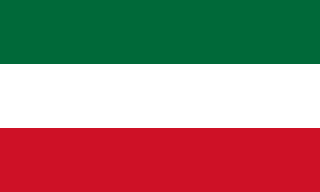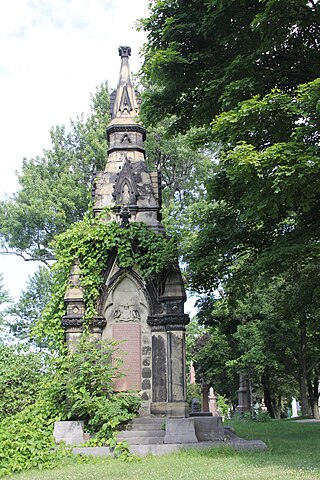
The Constitutional Act 1791 was an Act of the Parliament of Great Britain which was passed during the reign of George III. The act divided the old Province of Quebec into Lower Canada and Upper Canada, each with its own parliament and government. It repealed the Quebec Act 1774. The act remained in force until 1841, when it was largely repealed by the Union Act, 1840, which reunited the two provinces into the new Province of Canada. Some provisions relating to the clergy reserves remained in force. The remaining provisions of the act were repealed over time, with final repeal in 1966.

The Family Compact was a small closed group of men who exercised most of the political, economic and judicial power in Upper Canada from the 1810s to the 1840s. It was the Upper Canadian equivalent of the Château Clique in Lower Canada. It was noted for its conservatism and opposition to democracy.
Lower Canada Tories is a general name for individuals and parliamentary groups in Lower Canada, and later in the Province of Canada's division of Canada East, who supported the British connection, colonialism, and a strong colonial governor. They generally favoured assimilation of French-Canadians to British culture, laws, and the English language, and opposed democracy.
Joint premiers of the Province of Canada were the prime ministers of the Province of Canada, from the 1841 unification of Upper Canada and Lower Canada until Confederation in 1867.

The Parti canadien or Parti patriote was a primarily francophone political party in what is now Quebec founded by members of the liberal elite of Lower Canada at the beginning of the 19th century. Its members were made up of liberal professionals and small-scale merchants, including François Blanchet, Pierre-Stanislas Bédard, John Neilson, Jean-Thomas Taschereau, James Stuart, Louis Bourdages, Denis-Benjamin Viger, Daniel Tracey, Edmund Bailey O'Callaghan, Andrew Stuart and Louis-Joseph Papineau.

The Bank of Upper Canada was established in 1821 under a charter granted by the legislature of Upper Canada in 1819 to a group of Kingston merchants. The charter was appropriated by the more influential Executive Councillors to the Lt. Governor, the Rev. John Strachan and William Allan, and moved to Toronto. The bank was closely associated with the group that came to be known as the Family Compact, and it formed a large part of their wealth. The association with the Family Compact and its underhanded practices made Reformers, including Mackenzie, regard the Bank of Upper Canada as a prop of the government. Complaints about the bank were a staple of Reform agitation in the 1830s because of its monopoly and aggressive legal actions against debtors.
Social conservatism in Canada represents conservative positions on issues of family, sexuality and morality. In the European and North American context, social conservatives believe in natural law as well as traditional family values and policies. In Canada's modern context, social conservatism also includes pro-life values on abortion and euthanasia.

Daniel Tracey born in Roscrea, Tipperary County, Ireland, was a doctor, journalist and politician in Lower Canada.

The Legislative Assembly of Upper Canada was the elected part of the legislature for the province of Upper Canada, functioning as the lower house in the Parliament of Upper Canada. Its legislative power was subject to veto by the appointed Lieutenant Governor, Executive Council, and Legislative Council.
George D'Arcy Boulton was a lawyer, judge and political figure in Upper Canada. He was a member of the Family Compact, an oligarchic political and social group which dominated the government of the province.

The Executive Council of Upper Canada had a similar function to the Cabinet in England but was not responsible to the Legislative Assembly. Members of the Executive Council were not necessarily members of the Legislative Assembly but were usually members of the Legislative Council. Members were appointed, often for life. The first five members were appointed in July 1792. The council was dissolved on 10 February 1841 when Upper Canada and Lower Canada were united into the Province of Canada. It was replaced by the Executive Council of the Province of Canada the same year.

The Beiyang government was the internationally recognized government of the Republic of China between 1912 and 1928, based in Beijing. It was dominated by the generals of the Beiyang Army, giving it its name.
The Anhui clique was a military and political organization, one of several mutually hostile cliques or factions that split from the Beiyang clique in the Republic of China's Warlord Era. It was named after Anhui province because several of its generals–including its founder, Duan Qirui–were born in Anhui.

The Fengtian clique was the faction that supported warlord Zhang Zuolin during China's Warlord Era. It took its name from Fengtian Province, which served as its original base of support. However, the clique quickly came to control all of the Three Northeastern Provinces. The clique received support from Japan in exchange for protecting Japanese military and economic interests in Manchuria. The Fengtian Army frequently intervened in many of the conflicts of the Warlord Era.
The Constitutional Protection Movement was a series of movements led by Sun Yat-sen to resist the Beiyang government between 1917 and 1922, in which Sun established another government in Guangzhou as a result. It was known as the Third Revolution by the Kuomintang. The constitution that it intended to protect was the Provisional Constitution of the Republic of China. The first movement lasted from 1917 to 1920; the second from 1921 to 1922. An attempted third movement, begun in 1923, ultimately became the genesis for the Northern Expedition in 1926.
The CC Clique, or Central Club Clique, was one of the political factions within the Kuomintang, in the Republic of China (1912–49). It was led by the brothers Chen Guofu and Chen Lifu, friends of Chiang Kai-shek.
The New Guangxi clique, led by Li Zongren, Huang Shaohong, and Bai Chongxi, was a warlord clique during the Republic of China. After the founding of the Republic, Guangxi served as the base for one of the Old Guangxi clique, one of the most powerful warlord cliques of China. In the early 1920s, the Guangdong–Guangxi War saw the pro-Kuomintang New Guangxi clique replace the Old clique.

The Chiang-Gui War was a military conflict between the Nationalist government of Chiang Kai-shek against the warlord army of the New Guangxi clique that lasted from March until June 1929. A later conflict, the 2nd Chiang Gui-War, occurred between the two opposing factions in November and December of the same year.
Lobbying in Canada is an activity where organizations or people outside of government attempt to influence the decision making of elected politicians or government officials at the municipal, provincial or federal level.








